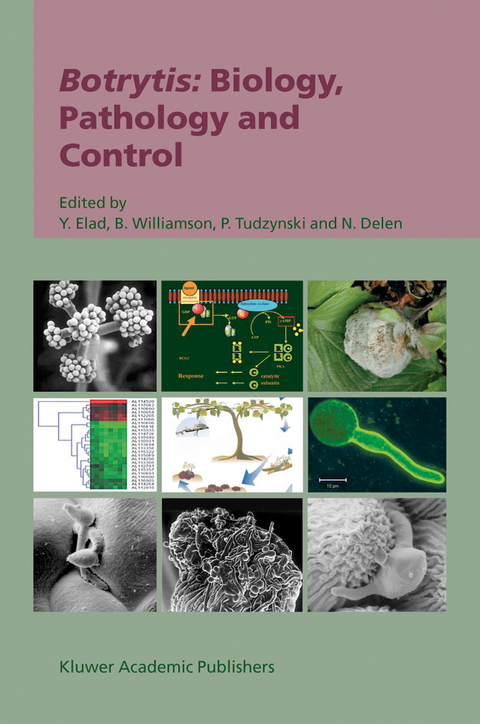
Botrytis: Biology, Pathology and Control
Springer-Verlag New York Inc.
978-1-4020-2624-9 (ISBN)
Botrytis cinerea and other Botrytis species are important pathogens of nursery plants, vegetables, ornamental, field and orchard crops and stored and transported agricultural products. Over the last 125 years, Botrytis spp. have been investigated by an increasing number of specialists in diverse fields including chemistry, biochemistry, molecular and cell biology, genetics, morphology and histology, taxonomy, host-parasite interaction, ecology and epidemiology and they have been the subject of an immense number of published studies. Considerable effort is invested in protecting the agricultural produce against Botrytis before and after harvest. The market size for anti-Botrytis products is currently estimated at US$ 15-25 million in recent years. The intensity of anti-Botrytis measures taken by farmers continued unabated throughout the last 20 years but our understanding of the processes that govern Botrytis life cycles, pathogenicity and epidemiology have become comprehensive. During the compilation of this book the aim was to create a most comprehensive treatise on the rapidly developing science of Botrytis and to serve as a stimulus to future research for the benefit of agriculture and horticulture and all those who serve these industries; i.e. researchers and students, farm advisers and agriculture specialists.
The book is the result of intensive work of 43 authors, all of whom are leading scientists in the Botrytis sciences. Each chapter describes a particular aspect of fungal biology and its impact on disease processes and host response. New technologies have arisen that when applied to long-standing problems or to test new hypotheses have been most rewarding and many of these are covered in this book. The chapters are cross linked so that readers can follow associated material to better understand the practical implications of the advances made in fundamental science. The twenty inter-connected chapters of the book are grouped according to three major themes: the fungus and its pathogenicity factors; plant reactions to infection; and epidemiology and management of important Botrytis-incited diseases. This book adopts a multidisciplinary approach to integrate the state-of-the-art knowledge in all key areas of common interest in the fungi and their plant interactions. The book includes detailed reviews of Botrytis spp. and the diseases they cause in plant systems and provides a comprehensive description of these fungal necrotrophs, including their diversity of response to the environment, their speciation and relatedness, sources of variation for evolution and molecular genetics and genomics. Aspects of Botrytis-host interactions, pathogenicity factors, the plant's reactions to infection, morphology and cellular organization, signaling, key enzymes, reactive oxygen species and oxidative processes in disease on-set, secondary metabolites as plant defense substances and the role of phytohormones in such reactions are emphasized in the book. Several innovative approaches for disease management of this group of destructive pathogens and methods of detection, epidemiological studies and chemical and biological control are also discussed.
Botrytis spp. and Diseases They Cause in Agricultural Systems – An Introduction.- The Ecology of Botrytis on Plant Surfaces.- Taxonomy and Genetic Variation of Botrytis and Botryotinia.- Approaches to Molecular Genetics and Genomics of Botrytis.- Morphology and Cellular Organisation in Botrytis Interactions with Plants.- Signalling in Botrytis cinerea.- Extracellular Enzymes and Metabolites Involved in Pathogenesis of Botrytis.- Botrytis cinerea Perturbs Redox Processes as an Attack Strategy in Plants.- Plant Defence Compounds Against Botrytis Infection.- Phytohormones In Botrytis-Plant Interactions.- Detection, Quantification and Immunolocalisation of Botrytis species.- Chemical Control of Botrytis and its Resistance to Chemical Fungicides.- Microbial Control of Botrytis spp.- Epidemiology of Botrytis cinerea in Orchard and Vine Crops.- Botrytis Species on Bulb Crops.- Biology and Management of Botrytis spp. in Legume Crops.- Epidemiology of Botrytis cinerea Diseases in Greenhouses.- Rational Management of Botrytis-Incited Diseases: Integration of Control Measures and Use of Warning Systems.- Post-Harvest Botrytis Infection: Etiology, Development and Management.- Innovative Biological Approaches to Botrytis Suppression.
| Zusatzinfo | 21 Illustrations, black and white; XIX, 428 p. 21 illus. |
|---|---|
| Verlagsort | New York, NY |
| Sprache | englisch |
| Themenwelt | Naturwissenschaften ► Biologie ► Botanik |
| Naturwissenschaften ► Biologie ► Mykologie | |
| Weitere Fachgebiete ► Land- / Forstwirtschaft / Fischerei | |
| ISBN-10 | 1-4020-2624-2 / 1402026242 |
| ISBN-13 | 978-1-4020-2624-9 / 9781402026249 |
| Zustand | Neuware |
| Haben Sie eine Frage zum Produkt? |
aus dem Bereich


